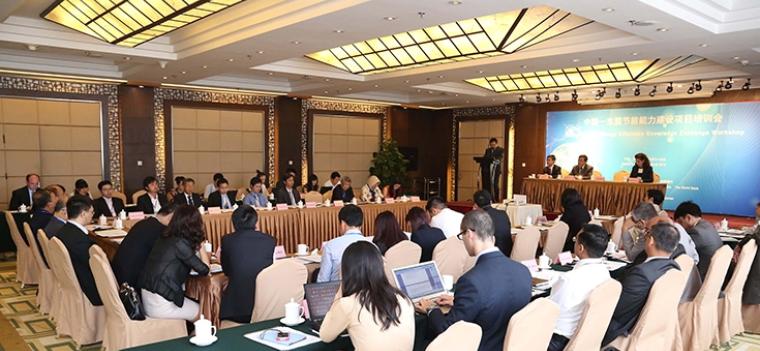News
- China has made reducing energy intensity one of the top priorities for the nation and made significant progress in energy saving in the past twenty years.
- Other Asian countries also put a high priority on energy efficiency and have set ambitious efficiency targets.
- At a knowledge-exchange event, participants from these countries shared experience on energy efficiency policies, financing mechanisms, and business models for energy service companies.
Beijing and Xi’an, China, June 27, 2014 – China has successfully decoupled energy consumption and emissions from economic growth. From 1980 to 2010, while China’s economy increased 18-fold, energy consumption increased only 5-fold. Energy intensity per unit of GDP declined by about 70 percent during the same period.
The Chinese Government has made reducing energy intensity one of the top priorities for the nation, and embarked on one of the most aggressive energy conservation campaigns in the world – China accounted for more than half the world’s entire energy savings in the past twenty years.
Other Asian countries also put a high priority on energy efficiency, and some, such as India, Thailand, and Vietnam, have set ambitious efficiency targets.
To disseminate lessons from China’s experience, the World Bank and China’s National Development and Reform Commission (NDRC) co-hosted a South-South knowledge exchange in China on June 16-20, 2014, which included workshops and a study tour in Beijing and Xi’an.
The event was attended by representatives from regional governments, bilateral and multilateral aid organizations, energy service companies (ESCOs), and financial institutions, and by practitioners from China, Cambodia, India, Indonesia, Laos, Malaysia, Myanmar, Singapore, Thailand, and Vietnam.
Participants shared knowledge and exchanged experience and lessons learned about energy efficiency policies, financing mechanisms, and business models for ESCOs. The event was supported by the World Bank’s Energy Sector Management Assistance Program (ESMAP) and the Asia Sustainable and Alternative Energy Program (ASTAE).
At the outset, the workshop made clear China’s achievements were largely thanks to the government’s commitment, ambitious targets, and effective policies for energy conservation and emission reduction.
“President Xi called for an energy revolution, and put energy conservation as the first priority to contain the energy growth in China,” said Deputy Director General Feng Liang of the NDRC’s Environment Protection and Resource Conservation Department in his opening remarks.
The government set a mandatory target to cut energy intensity per unit of GDP by 20 percent in the 11th Five-Year Plan (2006-2010), and renewed of its commitment with a targeted 16 percent reduction during the 12th Five-Year Plan (2011-2015). Strong regulatory policies and financial incentives have been put in place to ensure the targets are met. In addition, the government has also pledged to reduce China’s carbon intensity (carbon emissions per unit of GDP) by 40-45 percent from 2005 to 2020. Energy efficiency will make the single largest contribution to achieving this target.
Top Chinese EE experts presented how the national energy intensity reduction target was set for each province and for the nation’s top energy-consuming enterprises, and how the government had tightened energy efficiency standards for appliances, buildings, and vehicles. They pointed out that the government had allocated more than $15 billion during the 11th Five-Year Plan period, with additional funds from provincial governments, as incentives for energy efficiency investments and technology research and development. Provincial government officials and top EE experts from Shaanxi province presented how the national level EE targets and policies are implemented at the provincial level and in the key energy-intensive industries.
“The World Bank has played a significant role in introducing market-based approaches to improve energy efficiency in China, such as the ESCO concept and energy efficiency financing mechanisms, to help the Chinese government achieve its ambitious energy conservation and emission reduction targets,” said Xiaodong Wang, a senior energy specialist with the World Bank, in her presentation of the book onUnlocking Commercial Financing for Clean Energy in East Asia.
Over the past two decades, the World Bank and Global Environment Facility (GEF) have been working with China to help China move to more market-based approaches for energy conservation. This work has taken place in three phases: introduction of the ESCO concept to China by establishing the first three ESCOs; providing partial risk guarantees to help ESCOs access to financing; and, in the present phase, supporting the mainstreaming of energy efficiency lending in the Chinese banking sector through dedicated credit lines.
Today, the ESCO industry in China has grown from the initial three almost twenty years ago to nearly 5,000 companies with nearly $10 billion in energy performance contracts in 2012. Representatives from Chinese ESCOs presented their growth experience and business models. They also discussed lessons learned under the World Bank-financed China Energy Efficiency Financing program, which has financed nearly $1 billion investment to date and achieved mainstreaming of energy efficiency investments into the participating banks’ main business lines.
Chinese banks shared their financing models, such as project-based financing, to increase access to financing for ESCOs. The Chinese guarantee company and the International Finance Corporation (IFC) introduced their experience on guarantee mechanisms for energy efficiency in China.
“The ESCO industry and energy efficiency financing are important market-based mechanisms to promote energy efficiency in China,” said Jia Fusheng, Director General of the National Energy Conservation Center in his opening remarks.
Participants from Asian countries said they found the presentation of China’s experience useful. “As the national electricity company, we are under great pressure to invest in new power plants to fuel Vietnam’s economic growth. Energy efficiency is one of the key solutions to release this pressure. China has accumulated solid experience in the development and promotion of the ESCO industry,” said Tran Viet Nguyen from Electricity of Vietnam (EVN).
“Transforming China’s energy sector towards a low-carbon path is the most important climate change mitigation action in the world. We commend Chinese government’s strong commitment and effective policies to promote energy conservation and emission reduction,” said Marianne Fay, Chief Economist, Climate Change Group of the World Bank.
